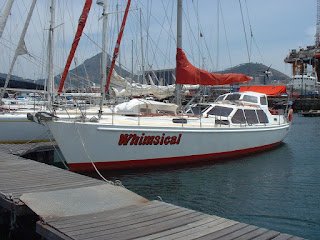We have a strong on-line presence and most of our business comes via our website. However, I built the bulk of that website in the mid 1990s, when the South African market had collapsed along with apartheid and was no longer able to sustain boat designers on local orders. I had learned to hand code html as a last ditch way of bringing food to the table for my family.
In the 80s I was building a nice international market, then politics got in the way with sanctions and I lost that international market very quickly. The same politics artificially inflated the demand for long distance sailboats in South Africa and that supported a few other designers, aside from myself, for a few years. When Nelson Mandela walked out of prison and the world didn't explode in horror, the demand for boats evaporated, many boats came onto the market and suddenly we were no longer able to sell our services.
Income went from fairly comfortable to almost zilch and I did not have the resources to wait for things to maybe change at some time in the future. I saw the newly spreading Internet as the only way that I was likely to rebuild my international market, to rescue my family from the jaws of starvation.
After a foray into website building software available at the time I soon realised that to make this work efficiently I would have to learn how to hand code. I did that with books and lots of trial and error. I also soon found out what worked for me in terms of the amount and type of information that I had to make available to visitors. I learned all about sizing graphics for efficient download and efficient coding for the same purpose.
In those days of universal dial-up Internet the dividends were great because my website was so much faster-loading than my competitors. We developed markets in faraway places because people could see what I wanted to show instead of waiting interminably for graphics that sometimes caused the download system to crash. Having only had dial-up myself, I knew that I had customers in Europe who wanted me to look at their projects on-line and I sometimes couldn't see more than 25% down a page loaded with photos before the download crashed. I swore to not be guilty of that error in my own website, so everything revolved around presenting info efficiently rather than trying to entertain visitors with fancy effects that waste download bandwidth.
Those days are long gone and we now live in USA with high speed fibre optic Internet access and very fast downloads. However, I have not forgotten the lessons learned about efficient downloads. I still have a considerable market in places that don't have high speed Internet. I keep my graphics small and my coding efficient for those people. My website has on occasion been criticised by some as "an eyesore" or other nasty descriptions but I let it wash over me. The criticism is undoubtedly from people who do not understand the demographic at which it is targeted.
Now, unexpectedly, we have gone full circle and efficient downloads are once again an advantage. I am relieved that I did not resize the photos on my site, which would have entailed many hundreds of hours of work.
The closing of this circle is due to the fact that more people are now using smart phones for their Internet access than their laptop or desktop computers. The importance for us vendors with websites is that download speeds with telephones and wireless services is considerably slower than it is with cable or fibre optics. Also, the size of a smart phone screen makes the use of smaller images quite practical. Smaller images give faster downloads, so the ever more impatient Internet traveller does not leave my website in disgust because it has not started to download within 5 seconds. Our attention span and demand for instant gratification is such that we want the information to appear in front of us almost at the same time as we click the link.
So, to finally get round to the purpose of this post, I have set up a mobile version of my website, optimised for efficient download onto the small screen using wireless downloads. The direct link is
http://m.dixdesign.com/ and will take you into the new mobile home page. From there you can choose links to browse our images in photo albums, view our YouTube videos, browse design pages or even place an order. If you prefer, you can also access our entire main website as you might have done before.
As always, we appreciate our customers and the support that you have given us over the past 30+ years, of which more than half have been since I built my first tentative website in the early hours of the morning and waited in terror for the visitors to arrive, to rescue us from our predicament. I say a big thanks to all of you, who now number in the thousands, for your support in the past and I assure you of our best intentions to keep you coming back in the future, with interesting design concepts to build.
Visit our main website at
http://dixdesign.com/
Visit our mobile website at
http://m.dixdesign.com/
































.JPG)




